It’s that time of the year when we can take a break from our gardening chores. However, if you subscribe to the notion that a gardener’s work is never done, I’m sure you’re already planning for next spring. And, you’re probably hoping that the gifts under the tree will help to fulfill your garden-oriented wish list.
On this month’s gardening journey, I’m providing several book suggestions that will inspire you to approach your planting in a fresh way. I’m also recommending several items of gardening gear. In this season of sharing, all would make thoughtful gifts.
Sprayer
 I never use any pesticides in my country garden, but I do regularly use an herbicide (Roundup™) to kill weeds around tree bases and stone foundations, as well as on very steep slopes. I also use it on expansive mossy areas I’ve established. The herbicides do not kill moss, but they take care of the weeds that are so tedious to remove. I do not apply it around my ponds or use it on windy days. For years, I’ve used a typical hand-pumped, 2-gallon green sprayer that one finds in every gardening center. It’s always challenging to use as it requires pumping every few minutes to restore the pressure, plus the spray frequently fails whenever a minute amount of debris gets into the system.
I never use any pesticides in my country garden, but I do regularly use an herbicide (Roundup™) to kill weeds around tree bases and stone foundations, as well as on very steep slopes. I also use it on expansive mossy areas I’ve established. The herbicides do not kill moss, but they take care of the weeds that are so tedious to remove. I do not apply it around my ponds or use it on windy days. For years, I’ve used a typical hand-pumped, 2-gallon green sprayer that one finds in every gardening center. It’s always challenging to use as it requires pumping every few minutes to restore the pressure, plus the spray frequently fails whenever a minute amount of debris gets into the system.
These annoyances are now a thing of the past. Last spring, I discovered Jacto’s compact, 2-gallon shoulder-carry sprayer that is perfect for home gardening and greenhouse use. For decades, Jacto has been a trusted provider of state-of-the-art commercial, tractor-powered, self-propelled and backpack (4-5 gallon) sprayers. The new 2-gallon model, pjb8c, weighs just over 5 pounds, and the spraying pressure is maintained constantly by a rechargeable lithium-ion battery. No pumping!
The sturdy tank is made of high-density polyethylene with a stainless-steel spray lance. If it’s operated constantly, the battery is reported to last up to four hours, but I’ve never proved that since I tire or finish long before. (It takes six hours to recharge the battery.) I particularly like that there is an internal filter that ensures debris never gets into the lines.
The sprayer lists for around $200 and should be available from agricultural suppliers listed on the Jacto website, jacto.com.
Bird Feeder
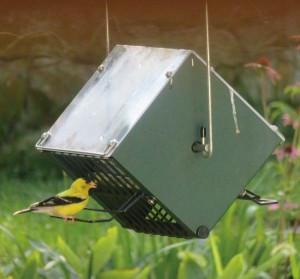 One of the many pleasures in our gardening journey is attracting songbirds to our gardens with feeders and enlisting our feathered friends’ help in controlling insect pests. Unfortunately, our feeders are often attacked by other pests! Sure, we can easily defeat the pesky squirrels with squirrel guards and position the feeders away from overhanging branches; however, the raccoons soon appear and effortlessly crawl around the guards. Large birds such as blue jays, pigeons and grackles also come calling and raid the feeders. What’s more, I’ve had a problem with deer sucking the seed out of my feeders!
One of the many pleasures in our gardening journey is attracting songbirds to our gardens with feeders and enlisting our feathered friends’ help in controlling insect pests. Unfortunately, our feeders are often attacked by other pests! Sure, we can easily defeat the pesky squirrels with squirrel guards and position the feeders away from overhanging branches; however, the raccoons soon appear and effortlessly crawl around the guards. Large birds such as blue jays, pigeons and grackles also come calling and raid the feeders. What’s more, I’ve had a problem with deer sucking the seed out of my feeders!
This summer I came upon the perfect bird feeder that totally defeats all these pests. It is called a RollerFeeder. Now, I take great pleasure in watching the completely befuddled squirrels being ejected by the unique rolling mechanics of this feeder. Those larger birds cannot access the perch nor can deer suck out the seeds. Thanks to this feeder, I can now watch my favorite birds flock to perch or cling to feed at the double stations. I am able to fill this feeder with the more-expensive sunflower seed hearts because there is no waste. The clever design also ensures that none of the feed is exposed to rain or snow, which means there are never clogged seed ports or wet seed trays. It is easily filled by rotating the housing.
Granted, this USA-made feeder is not cheap at around $75, but the housing is a high-strength aluminum alloy, the perches and hanger are coated steel, the bolts are stainless steel, and the perches are finished in a textured-powder coating. I figure it has quickly paid for itself with the savings on wasted feed. You can hang this feeder wherever you want. Watching the baffled squirrels try to figure it out is a gift in itself. It is available only from the website, rollerfeeder.com.
Hand Pruner
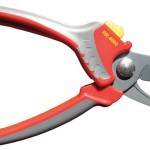 Many gardeners and arborists consider the Felco™ line of hand pruners to be the best, and I’ve recommended them in earlier gardening journeys. But, I’ve recently found a high-quality pruner that is made in Germany. Wolfgarten manufactures a line of high-quality gardening tools that is well known in Europe but is a bit harder to find here in the states.
Many gardeners and arborists consider the Felco™ line of hand pruners to be the best, and I’ve recommended them in earlier gardening journeys. But, I’ve recently found a high-quality pruner that is made in Germany. Wolfgarten manufactures a line of high-quality gardening tools that is well known in Europe but is a bit harder to find here in the states.
There are several models of pruners. I use the RR 4000 “Premium Plus”, which is a basic bypass pruning model that sells for around $23 (less than half the cost of a Felco). The pruners have a perfect weight and balance, especially for a person with average or small hands. They are compatible for left- or right-handed users and have comfortable soft-grip handles. Your hands do not tire quickly, even when you’re out and about in the garden for hours. Unlike most pruners, there is no exposed spring that gets dirty and rusts. I especially like the way the lock button works; it is easy to use even when wearing gloves (a gardening rule for my helpers is that leather gloves must be worn when using pruners). The blade has an anti-rust, non-stick coating that makes them easy to clean. I bought mine from Amazon, but readers might find them in specialty garden center racks. WOLF-Garten.com.
Books
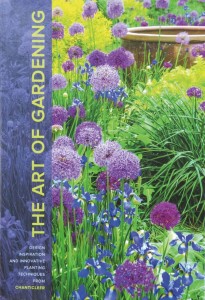 Chanticleer, in nearby Wayne (Chanticleergarden.org), has been called the most romantic, imaginative and exciting public garden in America. Unlike many public “display” gardens, it is filled with ideas and plants you can use at home, and since it is organized into many garden rooms, with the houses and structures integrated into the garden, the scale becomes similar to residential gardens.
Chanticleer, in nearby Wayne (Chanticleergarden.org), has been called the most romantic, imaginative and exciting public garden in America. Unlike many public “display” gardens, it is filled with ideas and plants you can use at home, and since it is organized into many garden rooms, with the houses and structures integrated into the garden, the scale becomes similar to residential gardens.
Now there is a new book written by R. William Thomas, the director, and the Chanticleer gardeners: The Art of Gardening (Timber Press). While the history of the garden is included, most of the book is devoted to a discussion of Chanticleer’s plants, including essays written by the horticulturists about their specific areas. There are oodles of practical design ideas that home gardeners can actually accomplish on a smaller scale. All the plants discussed will grow in our area. The book is sumptuously illustrated and will help both the beginner and experienced grower design a garden that is filled with great plants and little surprises.
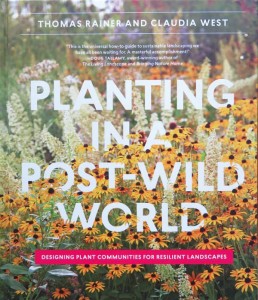 Another recently issued design book I consider a must-read is Planting in a Post-Wild World by Thomas Rainer and Claudia West (Timber Press). This visionary book discusses designing for the future using naturally-occurring plant communities and building landscapes that reconnect people to nature. It suggests we study the way plants grow dynamically together in “nature” and embrace that wisdom.
Another recently issued design book I consider a must-read is Planting in a Post-Wild World by Thomas Rainer and Claudia West (Timber Press). This visionary book discusses designing for the future using naturally-occurring plant communities and building landscapes that reconnect people to nature. It suggests we study the way plants grow dynamically together in “nature” and embrace that wisdom.
The book provides practical and detailed information for selecting the appropriate plants for a variety of sites and how to vertically layer plants into a naturalistic planting. “Our gardens will flourish because we have accepted the conditions we have and have chosen a group of plants that would naturally grow in similar conditions in nature.” The authors not only offer advice on what to plant but also how to plant. The issues of climate change and invasive species are discussed in depth. It is a landmark book on translating the lessons to be learned from a wild plant ecology into a home garden culture. The book’s message is that we need to design differently with a new set of rules and techniques based on the way plants naturally interact in a site and with each other with less emphasis simply on ornamental characteristics.
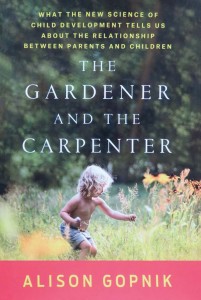 Another selection, The Gardener and the Carpenter (Farrar, Straus & Giroux), comes from Alison Gopnik, a California professor of psychology who writes widely about and is a recognized leader in the study of the ways children learn and develop. The book’s main thesis is that “helicopter” parents are limiting their children’s potential by shaping and controlling according to a scheme, like a carpenter, their every activity, hoping to achieve a particular kind of person. A gardener, on the other hand, attempts to create conditions in which plants will thrive while acknowledging that plants grow under their own nature and exhibit characteristics not necessarily under our control.
Another selection, The Gardener and the Carpenter (Farrar, Straus & Giroux), comes from Alison Gopnik, a California professor of psychology who writes widely about and is a recognized leader in the study of the ways children learn and develop. The book’s main thesis is that “helicopter” parents are limiting their children’s potential by shaping and controlling according to a scheme, like a carpenter, their every activity, hoping to achieve a particular kind of person. A gardener, on the other hand, attempts to create conditions in which plants will thrive while acknowledging that plants grow under their own nature and exhibit characteristics not necessarily under our control.
The author discusses parenting on the gardener’s model: the importance of creating a protective but nurturing space, and letting children’s minds explore; that play should be encouraged but not micro-managed; and school should be less about filling in quiz sheets. She argues that our goal should be helping children develop into individuals who can thrive in a changeable world and not simply gain early admission to Yale. It is a well-researched but very readable book that aims to correct the modern parenting model of constantly coaching and molding children by giving them opportunities to discover. This is a book to give to anyone you know who is a new parent (or grandparent). Actually, it should also be must-reading for teachers.





SHARE
PRINT